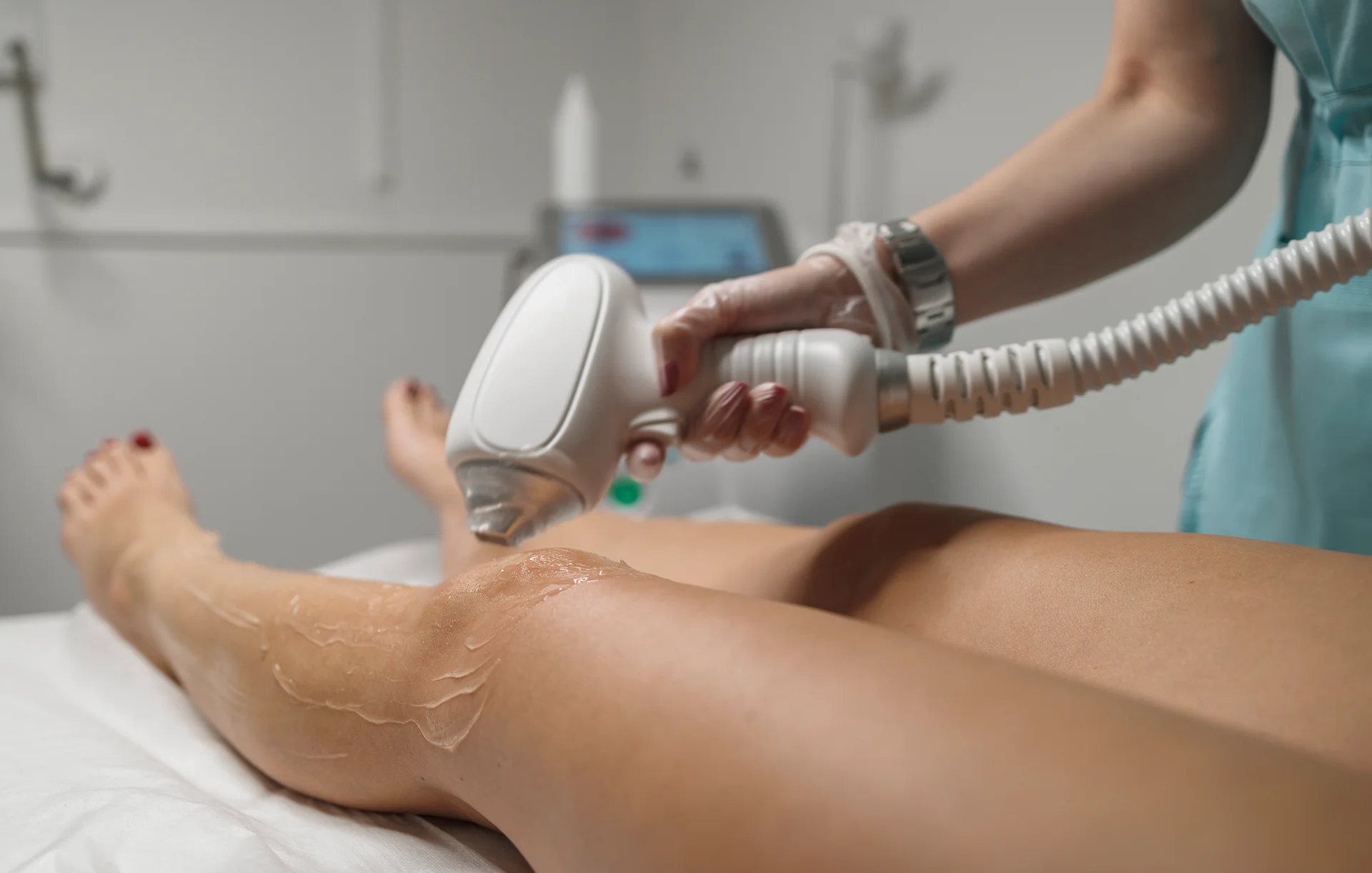The dark, dotted, strawberry-like bumps on your legs that resemble enlarged pores are likely keratosis pilaris, more commonly known as “strawberry legs.”
While the red bumps and dark spots may not be harmful, they can feel unattractive and uncomfortable. If you’re dealing with stubborn strawberry legs, you may have wondered if laser hair removal can help get rid of them for good.
Strawberry fields forever? Not for your legs! Turn to Ethos Aesthetics + Wellness for skin as smooth as your favorite tune.
What Exactly Are Strawberry Legs?
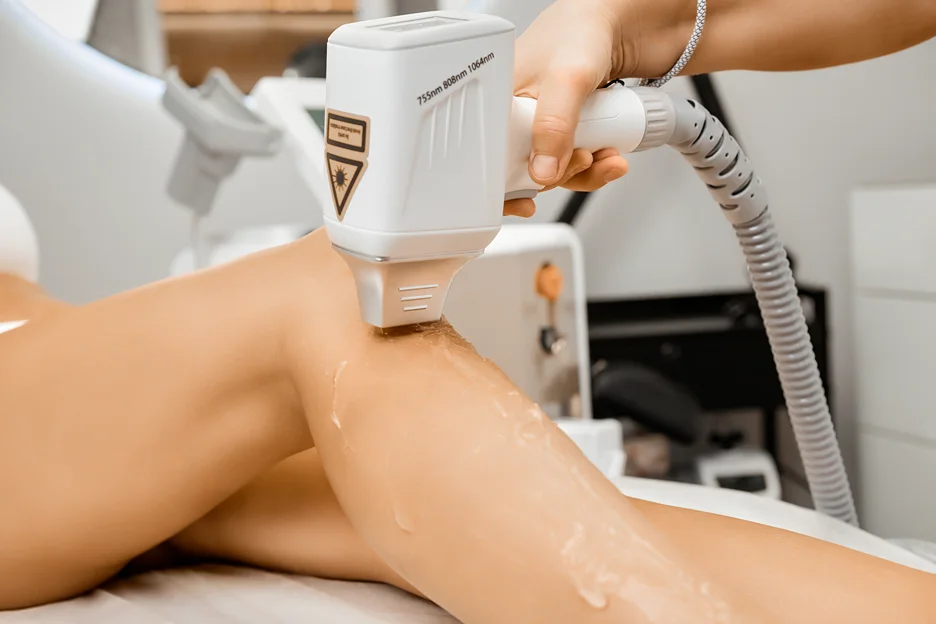
Strawberry legs refer to the appearance of black dots and dull red bumps that emerge on the skin. The bumps are often surrounded by small hairs. The texture resembles the seeds on the outside of a strawberry, hence the nickname “strawberry legs”.
The condition is caused by excess keratin plugging up hair follicles and pores on the legs. Keratin is a protein found in skin, hair, and nails that can build up and clog follicles.
Several factors can cause excess keratin production:
- Keratosis Pilaris – A common, harmless skin condition causing excess keratin around hair follicles. It shows up as rough, small bumps, usually on the upper arms and thighs.
- Folliculitis – Inflammation of the hair follicle often from friction, shaving irritation, or bacterial infection in the pores.
- Clogged Pores – Dead skin cells, oil, and bacteria can fill up pores and cause congestion.
The result is a bumpy texture and darkened pores on the legs that resemble strawberry seeds. While not medically dangerous, many find strawberry legs unsightly and want smoother skin.
How Does Laser Hair Removal Work?
Laser hair removal uses concentrated beams of light to selectively target and disable hair follicles. The lasers emit wavelengths of light that are absorbed by the pigment in hair. This builds up heat energy and damages the hair follicle, stunting future growth.
There are different types of lasers used:
- Alexandrite Laser – The fastest laser typically used for fair skin.
- Nd:YAG Laser – Longer wavelengths work better on darker skin tones.
- Diode Laser – Used for a variety of skin types but somewhat less effective.
During a treatment, the handheld device is placed against the skin while pulses of light remove unwanted hair follicle by follicle.
Most areas require multiple treatments spaced 4-6 weeks apart. With each successive treatment, more hair follicles are disabled until hair growth is significantly slowed or stopped completely.
Can Laser Hair Removal Improve the Appearance of Strawberry Legs?
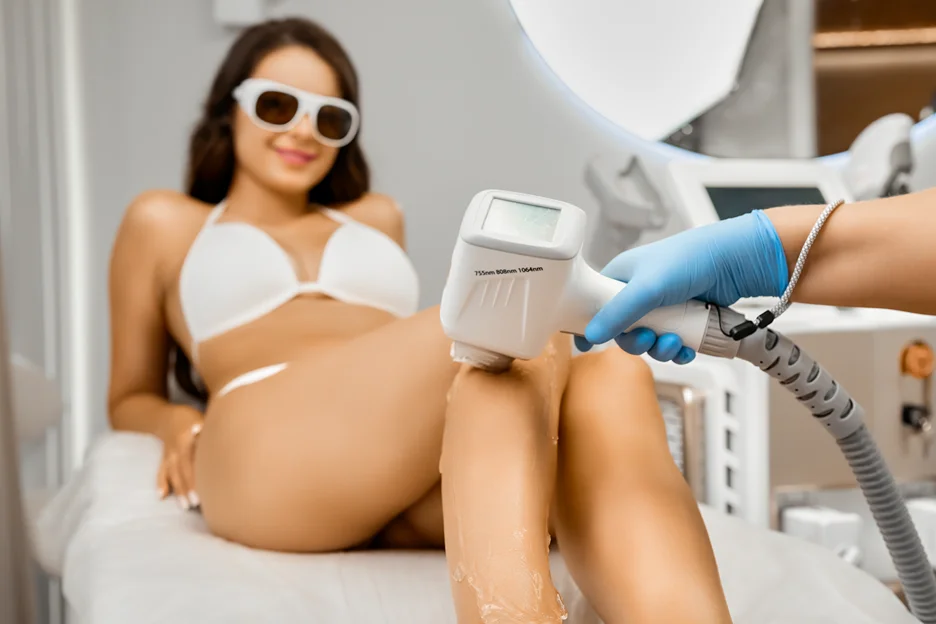
By directly targeting hair follicles, laser hair removal can be an effective treatment for improving the appearance of strawberry legs. Here’s how it helps:
Minimizes Dark Enlarged Pores
The heat from the laser damages the hair follicle beneath stubborn darkened pores. This can help shrink and reduce the darkened appearance.
Smooths Rough Bumpy Texture
Damaging the hair follicle can also minimize keratosis pilaris bumps and other follicular conditions causing a strawberry texture.
Prevents Ingrown Hairs
Ingrown hairs from shaving can worsen the bumps and irritation. Stopping hair growth prevents ingrowns.
Reduces Skin Irritation
For some, folliculitis bacteria contribute to the problem. Removing the hair and exfoliating the dead skin cells may combat this.
There is some debate about whether keratosis pilaris itself can be reduced, as it originates below the hair follicle in the dermis. However, by tackling all the surrounding factors, laser hair removal can make a significant improvement to the appearance of strawberry skin.
“We’ve seen excellent cosmetic improvements from laser hair removal on strawberry legs when performed properly,” says Dr. Hardik Soni of Ethos Aesthetics + Wellness. “It can effectively treat issues like ingrowns, debris-filled pores, and inflammation that accentuate the bumpy texture.”
How Does Laser Compare to Other Strawberry Leg Treatments?
Aside from laser hair removal, other options people try for improving the appearance of strawberry legs include:
- Exfoliation – Using physical scrubs or chemical exfoliators can help remove dead skin cells clogging pores. This offers mild improvement but doesn’t address the root causes.
- Retinoids – Prescription retinoids like tretinoin help exfoliate and normalize keratin production. Their effects are gradual and irritating to some skin types.
- Professional Extraction – Dermatologists can manually extract congested pores using sterile tools to reduce their appearance. This offers temporary relief and must be repeated.
- IPL Photofacial – Broad spectrum light can reduce redness and inflammation but doesn’t address hair or congested pores as effectively as laser.
Laser hair removal stands out for its ability to tackle multiple factors contributing to strawberry skin. As Dr. Soni explains, “ Lasers directly impair the follicles, preventing ingrowns, clearing pores, reducing inflammation, and stopping hair growth. No single treatment can match laser’s comprehensive effects on stubborn strawberry legs.”
How to Prepare for Laser Hair Removal on Strawberry Legs
To maximize the safety and efficacy of laser hair removal for strawberry legs, proper preparation is important:
- Avoid sun exposure on the legs for 2 weeks prior to treatment. Tanned skin is difficult to treat effectively and safely.
- Exfoliate gently with a loofah 1-2 times per week. Avoid harsh scrubs that can aggravate skin.
- Stop waxing/plucking/tweezing for 4 weeks beforehand. Laser targets the hairs, so they must be present.
- Allow any rashes or cuts to heal completely before treatment to minimize risk of infection or scarring.
- Moisturize the legs daily but avoid very thick creams before the laser appointment.
Proper preparation ensures the legs are in optimal condition for the laser to work safely and efficiently.
Don’t let strawberry legs be your summer bummer. Book your laser session at Ethos Aesthetics + Wellness and step out in confidence!
Post-Procedure Guidelines for Laser Hair Removal Aftercare
Following laser hair removal treatments on strawberry legs, be sure to:
- Avoid sun exposure and use SPF 30+ sunscreen if going outside. Treated skin is highly sensitive.
- Apply ice packs as needed to soothe discomfort and reduce swelling.
- Use over-the-counter pain relievers like acetaminophen if necessary. Avoid ibuprofen which can worsen swelling.
- Gently cleanse twice daily and apply a soothing moisturizer like aloe vera.
- Avoid hot baths, saunas, swimming for 72 hours post-treatment or until skin is healed.
- Wear loose breathable clothing while skin is healing. Friction can irritate treated follicles.
- Schedule sessions 4-6 weeks apart for optimal results over time.
Following proper aftercare allows the skin to heal smoothly while setting up the next session for success.
Customizing Laser Treatments for Each Patient’s Strawberry Legs
While laser hair removal can significantly improve strawberry legs, it’s crucial to tailor treatments to each patient’s unique skin:
- Skin type – Light vs darker skin requires different laser wavelengths and settings.
- Hair/Follicle characteristics – Coarse dark hair responds best. Fine blonde hair is difficult to treat.
- Severity – Mild vs severe strawberry texture may need different approaches.
- Other medications/conditions – Certain factors can affect treatment plan safety.
“We don’t take a one-size-fits-all approach to laser hair removal on strawberry legs,” says Dr. Soni. “A detailed consultation is performed to assess the individual characteristics and customize an optimal treatment plan.”
Working closely with an experienced dermatology provider ensures your strawberry legs get a personalized laser treatment tailored just for you.
What to Expect from Laser Treatments for Your Strawberry Skin
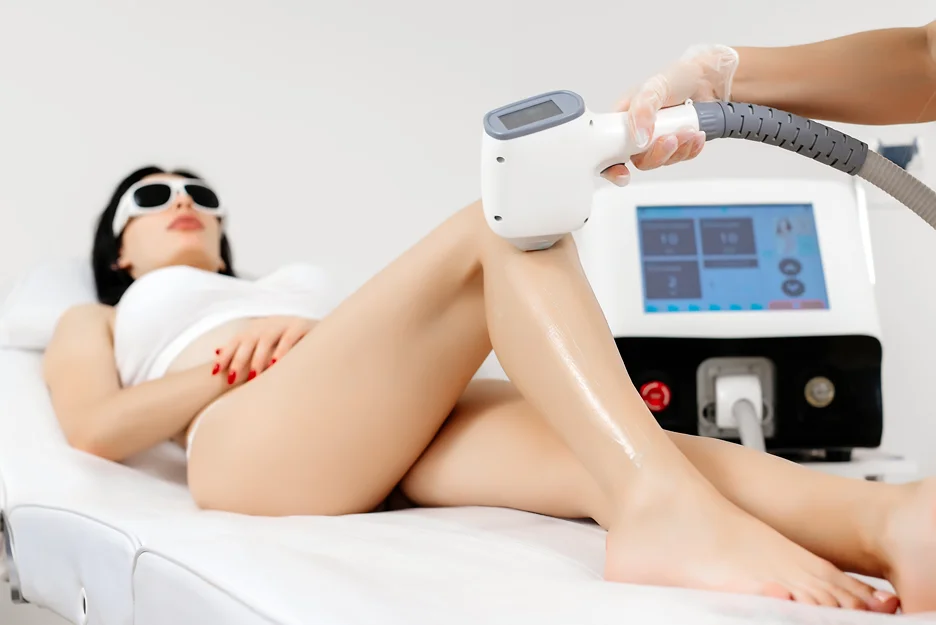
While laser hair removal is an effective treatment for strawberry legs, it’s important to have realistic expectations about the potential results:
- Gradual improvements over several sessions spaced apart. Instant dramatic changes are unlikely after the first treatment.
- Milder texture/appearance but likely not 100% removal of all bumps or spots. Genetic keratosis pilaris may persist.
- Possible mild redness, swelling, irritation for a few days after treatment. Use cooling and avoid friction over the treated areas.
- Maintenance treatments needed periodically as hair can regrow over time.
- Works best for milder cases – severe or resistant strawberry legs may see only partial improvement.
Combining laser with adjunctive therapies like gentle exfoliation can further enhance outcomes. But some amount of strawberry texture may remain for those genetically prone to it.
Is There Any Pain or Risks With Laser Hair Removal?
Laser hair removal is well-tolerated by most patients but there can be some minor discomfort and risks involved with the treatment:
- Pain – Most describe the laser feeling like a warm rubber band snapping against the skin. Pain is usually mild and dissipates quickly.
- Redness/Swelling – Temporary redness and swelling around the hair follicles is common after treatment and resolves within a few days.
- Skin Irritation – Heat from the laser can cause mild burns, blisters, crusting or other irritation if settings are too high. Proper protocols minimize this risk.
- Scarring – Burns from aggressive treatment can rarely cause permanent scarring but is unlikely with an experienced provider. People with keloids may be prone to scarring.
- Hyperpigmentation – Darker pigmented skin has a higher risk of temporary or permanent dark spots after treatment.
- Eye injury – Special safety eyewear must be worn to avoid accidental laser exposure to the eyes.
Dr. Soni ensures patients are comfortable during the process: “We provide topical numbing creams, cooling air devices and adjust settings appropriately. Our priority is keeping patients safe while delivering effective treatments.”
Proper patient selection and conservative treatment settings make laser hair removal a well-tolerated procedure for most seeking smoother strawberry skin.
Who is a Good Candidate for Laser?
The ideal candidate for laser hair removal for strawberry legs is someone who:
- Has light to medium toned skin (Fitzpatrick types I-IV)
- Has dark, coarse leg hair growth
- Is not overly prone to scarring/keloids
- Has mild to moderate strawberry legs
- Is committed to multiple treatments over time
Hair color, density, and skin type impact the efficacy and safety of laser for strawberry legs. An in-person exam helps determine if someone is a good candidate.
Those with very fair skin/hair, severe bumps, or dark complexions may get better results from alternative treatments. But many can benefit from laser’s ability to tackle the overlapping factors causing strawberry texture.
Tired of those berry bothersome bumps? Let Dr. Soni at Ethos Aesthetics + Wellness craft your smooth skin story. Connect with us today!
Combining Laser with Other Therapies
While laser hair removal targets many root causes of strawberry legs, combining it with other therapies can enhance results:
- Gentle exfoliation – Using lactic acid or urea creams can further smooth skin’s texture while lasers address the follicles.
- Moisturizing – Hydrating creams improve skin’s barrier function and calm inflammation.
- Photofacials – Intense pulsed light can diminish overall redness and rosacea symptoms associated with strawberry legs.
- Topical retinoids – Creams containing retinoids help normalize keratin production and unclog pores.
“We often advise patients to incorporate adjunctive therapies that complement the laser treatments for optimal improvement of their strawberry skin,” advises Dr. Soni.
No single treatment is a miracle cure for stubborn strawberry legs. But strategic combinations provide incremental improvements that can dramatically smooth your skin over time.
Consulting an Experienced Laser Treatment Provider
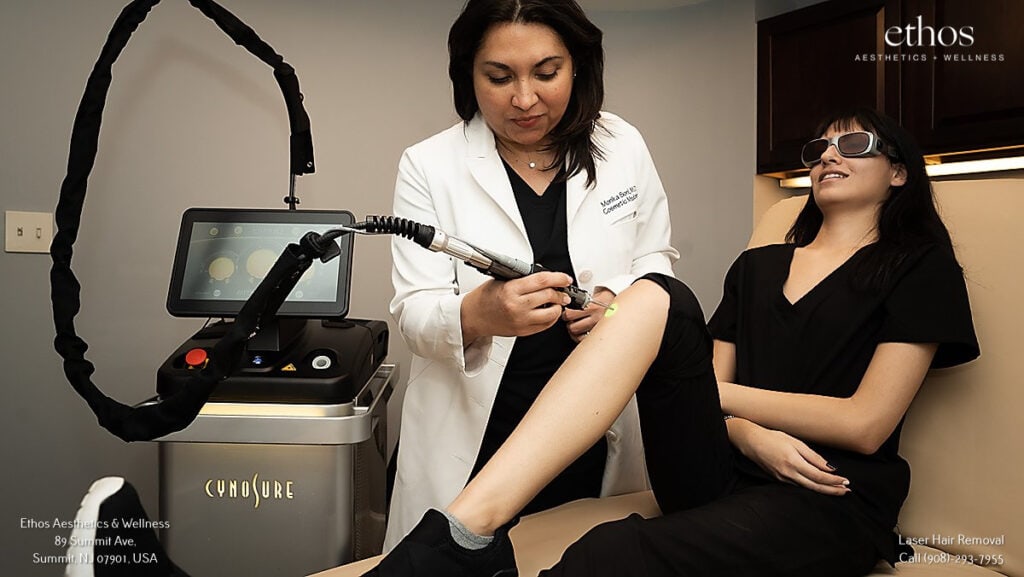
While lasers offer a way to combat multiple causes of bothersome strawberry legs, it’s important to have realistic expectations about potential improvements. Consulting an experienced provider is crucial before pursuing treatment.
“We carefully assess each patient’s specific situation to determine if laser hair removal is likely to benefit their strawberry legs,” says Dr. Soni. “If expectations aren’t properly managed or alternative therapies may be better, we will guide patients accordingly.”
Working with a knowledgeable dermatologist ensures you get candid advice about whether laser is right for your individual case of strawberry legs. While the technology has advanced, stubborn bumps may persist. But the right treatment plan can help smooth your skin’s texture and appearance considerably.
If you’re bothered by dark dots, ingrowns, and irritating bumps on your legs, know that you have options. Reach out to Ethos Aesthetics + Wellness to determine an effective treatment plan for achieving your best looking skin. Contact us today to schedule a consultation.

